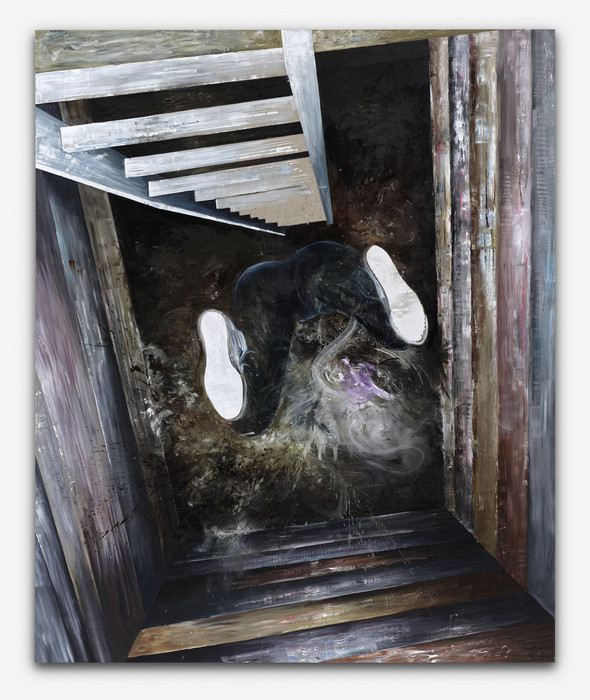Neverend in Everland
10 Oct - 17 Nov 2007
Union is pleased to present the first solo show in the UK by internationally acclaimed Berlin-based artist Bernhard Martin.
Known for paintings and large installations that ambitiously pastiche heterogeneous styles and, at times colliding, representational models into idiosyncratic visual forms, the German artist’s practice encompasses many figurative and abstract registers to facilitate an alternative context in which to perceive his vibrant, colourful environments.
According to art historian Mark Gisbourne: “For Bernhard Martin a painting completes an image in the way a collage cannot.” (cat. Painter As Vagrant, Villa Arson, 2004) Martin’s daring approach in experimenting with different techniques impresses for the spontaneity, humour and confidence with which paintings, collages, ceramics and sculptures become a conglomerate of rudely sketched, grotesque images of fantastical portraits and scenes. Although revisiting precursors as Rembrandt, Picasso, Picabia, Warhol and Richter as well as art historical movements like German Pop, Surrealism, Cubism and Pointillisme, Martin equally explores contemporary graphics through the fields of cartooning, computer technology, illustrations from medical and children school books. Since the beginnings of his career, the artist has gone beyond the mere play with such sources, desiring to preserve a witty anti-quotational stance in order to direct the viewer’s attention onto his own distinctive, formal eclecticism. Caricatured button eyes made with wax or potato prints, smudged mouths intermingled with Plexiglas panels giving the illusion of multi-planar compositions as in Cubism’s research for disrupted planes, have become iconic examples of his non-linear mark making methods, where enthusiasm is at the core of his whole practice.
The works in this exhibition demonstrate Martin’s freedom in the way his forms and subject matter search for the meaning of painting, a quest similar to that for heaven that, despite it can never be found, won’t ever cease. All themes, which include a very large bronze and glass sculpture of a lying figure dominating the gallery space, refer to such a challenge, unravelled in stages as in the epic of the Seven Deadly Sins of Dante Alighieri’s The Divine Comedy. Surreal, psychedelic, Goth or kitsch, Martin’s works investigate “the clash between worlds, islands, chambers of marvels, biotopes, contrasts. In other words, everyday life.” (B.M.) His shameless violation of genres making use of black and chalky pastels, surfaces eliminating dimensions and contradicting the symbiotic relation between foregrounds and backgrounds, point at the visual infrastructure of an artist who, courageously misquoting Robert Musil’s celebrated novel for titling one of his paintings, is cynically able to create a “Bild ohne Eigenschaften” (work without qualities).
Known for paintings and large installations that ambitiously pastiche heterogeneous styles and, at times colliding, representational models into idiosyncratic visual forms, the German artist’s practice encompasses many figurative and abstract registers to facilitate an alternative context in which to perceive his vibrant, colourful environments.
According to art historian Mark Gisbourne: “For Bernhard Martin a painting completes an image in the way a collage cannot.” (cat. Painter As Vagrant, Villa Arson, 2004) Martin’s daring approach in experimenting with different techniques impresses for the spontaneity, humour and confidence with which paintings, collages, ceramics and sculptures become a conglomerate of rudely sketched, grotesque images of fantastical portraits and scenes. Although revisiting precursors as Rembrandt, Picasso, Picabia, Warhol and Richter as well as art historical movements like German Pop, Surrealism, Cubism and Pointillisme, Martin equally explores contemporary graphics through the fields of cartooning, computer technology, illustrations from medical and children school books. Since the beginnings of his career, the artist has gone beyond the mere play with such sources, desiring to preserve a witty anti-quotational stance in order to direct the viewer’s attention onto his own distinctive, formal eclecticism. Caricatured button eyes made with wax or potato prints, smudged mouths intermingled with Plexiglas panels giving the illusion of multi-planar compositions as in Cubism’s research for disrupted planes, have become iconic examples of his non-linear mark making methods, where enthusiasm is at the core of his whole practice.
The works in this exhibition demonstrate Martin’s freedom in the way his forms and subject matter search for the meaning of painting, a quest similar to that for heaven that, despite it can never be found, won’t ever cease. All themes, which include a very large bronze and glass sculpture of a lying figure dominating the gallery space, refer to such a challenge, unravelled in stages as in the epic of the Seven Deadly Sins of Dante Alighieri’s The Divine Comedy. Surreal, psychedelic, Goth or kitsch, Martin’s works investigate “the clash between worlds, islands, chambers of marvels, biotopes, contrasts. In other words, everyday life.” (B.M.) His shameless violation of genres making use of black and chalky pastels, surfaces eliminating dimensions and contradicting the symbiotic relation between foregrounds and backgrounds, point at the visual infrastructure of an artist who, courageously misquoting Robert Musil’s celebrated novel for titling one of his paintings, is cynically able to create a “Bild ohne Eigenschaften” (work without qualities).

